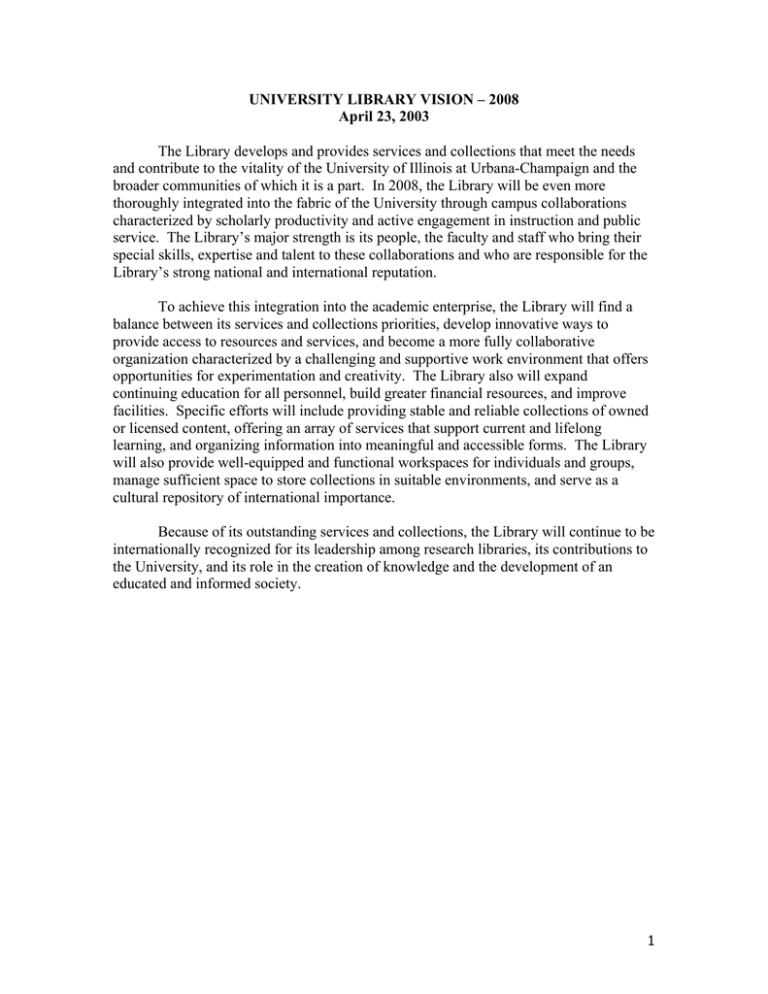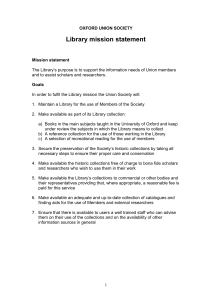UNIVERSITY LIBRARY VISION – 2008 April 23, 2003
advertisement

UNIVERSITY LIBRARY VISION – 2008 April 23, 2003 The Library develops and provides services and collections that meet the needs and contribute to the vitality of the University of Illinois at Urbana-Champaign and the broader communities of which it is a part. In 2008, the Library will be even more thoroughly integrated into the fabric of the University through campus collaborations characterized by scholarly productivity and active engagement in instruction and public service. The Library’s major strength is its people, the faculty and staff who bring their special skills, expertise and talent to these collaborations and who are responsible for the Library’s strong national and international reputation. To achieve this integration into the academic enterprise, the Library will find a balance between its services and collections priorities, develop innovative ways to provide access to resources and services, and become a more fully collaborative organization characterized by a challenging and supportive work environment that offers opportunities for experimentation and creativity. The Library also will expand continuing education for all personnel, build greater financial resources, and improve facilities. Specific efforts will include providing stable and reliable collections of owned or licensed content, offering an array of services that support current and lifelong learning, and organizing information into meaningful and accessible forms. The Library will also provide well-equipped and functional workspaces for individuals and groups, manage sufficient space to store collections in suitable environments, and serve as a cultural repository of international importance. Because of its outstanding services and collections, the Library will continue to be internationally recognized for its leadership among research libraries, its contributions to the University, and its role in the creation of knowledge and the development of an educated and informed society. 1 ACHIEVING THE VISION The Library will be an Integral Part of the University The Library will be integral to the vitality of the University and its teaching, research, service, and public engagement activities. In 2008 the Library will be viewed as a valuable and necessary part of the educational process. In order to meet the needs of a more interdisciplinary university, Library faculty will develop closer ties with the teaching and research faculties. This collaboration will exploit the long-standing tradition of close ties with teaching departments, as well the advances in information technology that support the development of curricular and research programs. Increased involvement with student learning and faculty research will be possible in great part because of information technology that will enable the Library to be ever-present in the classroom, in the laboratory, and at users' workstations. Complementary Services and Collections will be the Central Focus Developing and fostering the integration of the Library into the fabric of the University will occur through two complementary priorities: excellent services and world-class collections. What users will need and demand most will be simple and easily understood methods to discover, retrieve, and use information for classes and research. Achieving this goal will involve a variety of approaches such as changes in the hours that library resources and librarian expertise are available to users, modes of information delivery that are more responsive to users’ changing needs, and a more dynamic and unified Web presence. The value of the Library for faculty and students will be directly dependent on their ability to learn to use resources effectively and productively. To some degree, helping users develop information skills is the responsibility of everyone working in the Library and is a natural complement to the Library’s role in the educational process. This involvement in teaching and learning will be encouraged actively because it fosters the growth of the Library and innovation in services that support the overall mission of the university. The Library will be an Innovator and Leader in Access Access will be provided to everything owned or licensed. For items still lacking full access, plans will be developed to provide direct access or alternative options. Access will be targeted to materials in Library collections in all formats, print as well as digital, published and unpublished, and will extend beyond what was thought of as “our collection” a decade ago. Improved access will be a central focus because collections without easy access are not used. Innovative approaches to providing access such as using metadata tags for collections will become routine. The Library will continue to lead the nation in access innovation due to the active involvement of library personnel in creative adaptations of information technologies. By 2008 the card catalog will be retired because online access will have been enriched beyond what the card catalog could provide. The print collection will distinguish the Library from many other research libraries not only by its size, but also by the depth and breadth of its holdings. In this era of digital libraries, a print collection is fast becoming a special collection in and of itself. 2 Because of the richness of the print collections the Library will be a central node and a leader in national and international networks of print repositories. The preservation of collections, both print and digital, will be a vital aspect in the delivery and use of information to users and will no longer be an afterthought. When an item is acquired there will be a place to put it, a suitable storage environment, and a plan for preserving and accessing it. The Library Will Have a Culture that Fosters Collaboration and Innovation Innovations and responsiveness to library users will improve because the Library culture will have evolved. This often overlooked part of organizational dynamics involves simplifying the use of the library system itself, one of the largest and most complex such systems in the world. To reflect the changes in the University and the interdisciplinary collaboration among departments, the Library will become a much more integrated organization. This will be achieved through greater emphasis on internal collaboration that in turn will have been facilitated by advances in the information technology infrastructure. Administratively, the Library will engage in integrated planning and assessment with improved systems of data collection and management and better ways to assess the delivery of services. Because accountability must be an integral part of the plans, internal processes will move faster, and meetings will focus on productive outcomes where innovative ideas are discussed and things get done collaboratively and efficiently. Changes in culture will include using e-mail and intranets more wisely for collaboration and task accomplishment. Library faculty and staff will integrate research more closely into their own work, thereby benefiting not only the Library, but other research libraries around the globe. Quality and Effectiveness of the Library Dependent Directly on its Faculty and Staff The Library’s faculty and staff will remain the most important part of its intellectual enterprise. The Library’s most significant role in the future will be as the place where faculty and students go – physically or virtually – for help in finding the information resources they need or in creating new knowledge of their own. To ensure that the Library faculty and staff are equipped to play this expanded role, strong education and training programs will be implemented to ensure the competence of librarians and staff. Among these will be orientation programs for new Library faculty and staff, a professional development program tailored for both tenured and untenured faculty, and a staff education program that can recognize and support competence. The Library’s faculty and staff will be a more diverse group as a result of stronger recruitment and retention efforts. Diversity will also enable the Library to become even more responsive to the needs of users. In addition, as a sign of the value placed on longevity and expertise, the Library will have more full professors than a decade ago, as well as more endowed chairs and professorships. Financial Resources Will Be Greater One over-riding element in the Library’s success will be greater financial resources. The Library will double its endowment size and the number of Library Friends; receive more gifts from campus faculty due to targeted campaigning; and have 3 more endowed positions. This will occur not only because of the Library Development Office and its staff but because more Library faculty will become active grant seekers. Budgeted support from the University will increase in recognition of the Library’s strength and importance to the campus. Facilities will be Improved The Library’s vitality will be reflected in noticeable improvements in facilities. The main library will have a state-of-the-art instructional space, a Special Collections building with multi-purpose facilities for instruction and lectures will be in the planning stages, and the Undergraduate Library will be undergoing renovation. Staff and users will have ergonomically acceptable working conditions; all shelving locations will be at reasonable capacities; and many “smart” building innovations and environments will be adopted, including wireless installations and electronic security. 4






